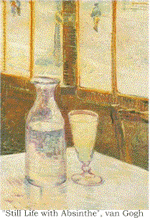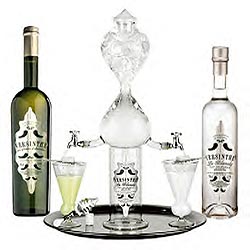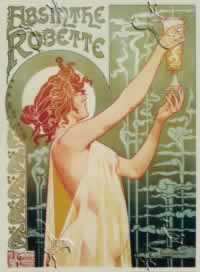|
 |
|
|
drinks
coffee
armagnac
grappa
beer
food
|
| |
|
|
| |
|
index
my
family
my home village
mobile
communication
music
psion
guestbook
home
|
| |
| |
|
"Meum est propositum in Taberna
mori"
|
| |
|
 |
|
| |
ABSINTHE |
|
- The Green
Muse
- La Fee Verte
|
|
|
|
|
|
|
|
| |
|
|
|
Absinthe is an
alcoholic drink made with an extract from wormwood (Artemisia
absinthium).
Absinthe or "the
green muse"appears to have been believed to stimulate creativity.
Below I have a
gathered some links to some fairly good web page treating different
sides of this mysterious, vivid liqueur that inspired many famous
artists.
|
|
|
| |
|
|
|
|
| |
|
Absinthe is an
ancient, bitter liquor originally made by soaking the leaves of the
wormwood herb in wine or spirits, absinthe was so unpleasant that its
name is believed to be connected with the Greek word "apsinthion,"
meaning "undrinkable." Despite its taste absinthe has long attracted a
bohemian following, largely for its hallucinogenic properties.
In ancient Greece,
thinkers like Pythagoras recommended that pregnant women drink absinthe
to ease labor pains. Centuries later, Swiss villagers in the Alps
concocted their own version of the liqueur, distilling wormwood with
anise seed and other popular herbs, and using it as a common folk
remedy. In the late 19th century, the most faithful drinkers of "the
green fairy" were European artists, including Impressionist painters
like Manet, Degas, and van Gogh. Authors like Paul Verlaine and Arthur
Rimbaud also favored the green liqueur.

In 1263, the Guild of
Anisette Workers was formed in the rue Vieille-du-Temple. Its members
ground star anise with a rounded pestle and macerated the powder for
use in preparations for ointments, medicines and liqueurs.At the end of
the 18th century, the Henriod Damsels of Val de Travers in the
Neuchatel Canton of Switzerland combined the benefits of anise and
grand absinthe to make an elixir. They grew the plants themselves in
their garden and distilled them in their kitchen, using a small still
on a tripod over the hearth. A French doctor exiled from Franche-Comtè,
Doctor Ordinaire, prescribed the elixir to his patients suffering from
stomach problems.
|
| |
|
|
| After his death the production went commercial
in 1797, when Henry-Louis Pernod purchased the secret recipe and opened
an absinthe factory in Pontarlier, France. During the early 1900s
Switzerland continued its production, exporting more than 3 million
gallons each year, and by 1910, absinthe sales had reached 32 million
liters annually in France. |
|
|
| |
|
|
| |
| Wormwood,
however, contains thujone, a psychoactive ingredient similar to
marijuana's key component (THC). Thujone is toxic to the brain and
liver, and over time may cause convulsions, hallucinations, and
psychoses. Absinthe eventually became viewed as a health risk;
Switzerland banned it in 1908, the United States followed in 1912, and
by 1915 even France had outlawed it. |
|
|
|
artemisia absinthium
|
| |
|
In 1920, five years after
its ban in France, Absinthe made a legal comeback- well, sorta. Pernod,
who had been churning out Absinthe since 1805, came out with an
Absinthe-like drink called- surprise- Pernod, which is widely available
today. The recipe, though, isn't the same. Among other things, the
wormwood had been all but removed. Wormwood, as you likely know,
contains the psychoactive chemical, thujone. Absinthe orignally had
some where around 100 milligrams of Thujone per liter.Today the thujone
concentration (it varies from 10 mg to 30 mg or even more) in Absinthe.
But Pernod has nearly none, as do Absente and Versinthe, which have 3.5
and 1.5 milligrams per liter, respectively. Pernod is vol. 40% (80
proof), Versinthe, vol. 45% (90 proof), and Absente, a hefty vol. 55%
(110 proof) The accepted concentration by European Community today is
10 mg thujone/54% alchol graduation.
Absinthe substitutes arose
in response, including wormwood-free drinks like ouzo, anis (anisette),
and Pernod, which taste similar to their infamous predecessor. Absinthe
remains legal in a few countries, however, such as Spain and the Czech
Republic, and with the availability of on-line ordering, it began
making a comeback in the late 1990s, despite its dangers.
|
|
In the U.S., original
Absinthe is illegal to sell for human consumption because it contains
thujone, which is banned by the Food and Drug Administration (FDA) for
use in foods for human.
|
|
|
|
|
|
|
|
|
| |
|
|
|
|
| |
|
|
| |
Below have I assembled some links related to Absinthe
|
|
| |
|
|
|
|
|
|
|
|
|
|
| |
|
|
|
|
| |
|
|
|
|
| |
|
Successor
of Absinthe
|
| |
|
In
Absente,
Absinthe Refined, is the
Wormwood, the botanical that caused the initial ban, replaced with a
less bitter cousin called Southern-Wormwood, also known as "Petite
Absinthe,"
Absente - Absinthe Refined
|
| |
|
|
Pernod is now launching a new product “Pernod aux
extraits de plantes d’absinthe”. Like the product sold in the 19th
century, this new spirit has an alcohol content of 68° and contains no
added sugar, but with thujone content in accordance with the
legislative constraints in force. Made from extracts of "roman
wormwood", "wormwood" and a blend of other aromatic herbs, this drink
is inspired by the old formula
Pernod site
|
| |
| Viewpoints: |
| Smoothe taste
but lacks complexity and effects other than that of alcohol. A nice
pastis but the best parts are absent. . |
| |
|
|
|
|
| |
|
|
In
Aix en Provence do
Liquoristerie De Provence produce Versinthe
and Lamesinte.
|
 |
| Versinthe
did first appear in February 1999. |
| Liquoristerie
De Provence |
| |
|
| |
|
|
|
|
|
|
|
|
| |
|
|
| |
|
Adding Wormwood,
is it advisable?
|
|
|
|
|
---------
|
| "Most Spanish and
Swiss absinthe is potent enough, as is the Frenche Le Fee. Simply
adding wormwood to bad absinthe won't always have the desired effect. |
| |
| Definitely be careful
if you're going to use wormwood oil! 1tsp. per fifth is plenty. If you
buy good absinthe, you needn't add anything. |
| |
| Fake absinthe
isn't worth wasting the money on. I have heard nothing
but bad things about the Czech brands. The variety I make is quite
potent and has a good flavor. If you don't want to go through the
trouble of research, assembling a lot of herbs, and experimenting in
order to make it yourself, it's better to get a quality absinthe and
enjoy it. Trying to fake it on the cheap can be dangerous and is less
than appealing to the palate." |
| |
|
| |
| |
|
|
|
